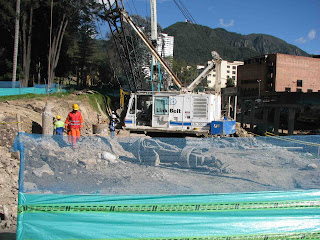 |
| Johanna and her poem. |
I don't know her history well, but her roots are in San Andres, a Carribean island which is probably Colombia's most unlikely territory. She's also lived in different parts of mainland Colombia and says she was displaced by violent groups, who forced her to move to Bogotá.
 |
| Here's my poem. |
'Razon de Tu Silencio'
'Me gusta tu silencio cauto, donde urgas mi silencio vacio. Donde me hablas sin palabras y me escuchas sin oidos....'
Nice, but I doubt it was written by a woman who evidently has a substance abuse problem. On the other hand, who am I to judge? I couldn't find those phrases via Google, and lots of great writers have had abuse problems....
A note about San Andres:
Located off of Nicaragua's coast, San Andres forms an archipelago also including Providencia and Santa Catalina, as well as lots of atolls and banks. The first Europeans to settle the islands were British Puritans - the same folks who settled New England. The islands were later controlled by the Spanish, by pirates and even a French corsair flying the Argentine flag. After Latin America's independence, the islands decided to join La Gran Colombia - but their nationality made less geographic sense after U.S. Pres. Teddy Roosevelt chopped off Panama and made it an independent nation in order to dig the Panama Canal, leaving the islands far from the rest of Colombia. Nicaragua still has claims to the archipelago, altho Colombia's hold on it seems strong. Today, the people there speak a kind of English, tho mixed with such a potpourri of words from other languages that it's not easy for an outsider to understand. The islands' sun and sand have made them popular with tourists.
 |
| San-drenched San Andres - a long ways from drizzly Bogotá |
By Mike Ceaser, of Bogotá Bike Tours























































